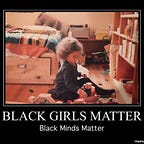A Better Version of Us Is Possible
It has been pointed out to me before that growing up in Los Angeles probably gave me an unusual perspective, and a recent study for the first time helped me see in quantifiable terms just how true that is. Los Angeles is off the charts unusual, and not just because of Hollywood. Even though I was born in the early 80s, I went to a pre-school where I wasn’t the only child with a Black parent and a white parent. There was also a kid at the school with a Black mom and an Asian American father figure. We learned Spanish and basic American Sign Language, and the school was accessible to and mostly populated by working class families like the one I was born into.
My white Jewish father was a gas man and union organizer, and my Black Caribbean mom was a teacher turned stay at home mom and activist. Although they eventually separated and divorced, with my mom taking the primary responsibility of raising me at home in largely Latino east Los Angeles, they still have a good political working relationship. The community that they were a part of and they raised me in was incredibly diverse and highly intersectional too. To be lesbian or queer was normative, to have a disability that one expected to be fully accommodated was normative. My earliest memories are of rooms full of people of European, Asian, African, Latin American, and Native American heritage coming together to make the world a better place.
I took this version of “normal” into the Los Angeles Unified School District magnet system when I entered it as a six year old. LAUSD’s magnets are different from the ones I’ve seen in other urban areas. Except for the magnets for gifted and highly gifted students, there is no intellectual admission criterion, and the schools were created as part of a legal mandate to integrate. This meant that my schools were incredibly diverse, both ethnically/racially and socioeconomically. There were kids in my classes who had Emmy-award winning producer parents and whose families had been in the U.S. for generations; there were kids in my classes whose parents had fled political persecution in their home country and were working low-income jobs at convenience stores. As a result, from first grade through high school graduation, my social circle was ethnically and socioeconomically diverse.
These schools were still far from perfect. My elementary school closed during the 1992 Los Angeles Riots because it was in South L.A. When it reopened, our teacher told us Black students, “If you don’t like it here, go back to Africa.” The riots happened because there were and still are tremendous problems in the wider community with poverty, police violence, and a lack of equal access to resources. Our schools were not immune to these problems, and this was reflected in the disparate ways, for example, I was treated as a high performing student versus students of color who likely were not getting enough to eat at home.
Even so, my childhood taught me that a better world than the one we live in is possible. And that is why I fight against the structural features that traditionally divide us from one another. I am opposed to white supremacy because it harms our ability to come together across racial divides, and it cruelly does so by elevating the interests of people who can believably identify as white at the expense of people who cannot. I am opposed to other -isms that operate similarly. But while I recognize that all forms of discrimination are harmful and many are deeply embedded in our society, white supremacy has a special place in America and American history. It was written explicitly into the constitution when Blacks were counted as less than 100% human. Then, a whole war was fought over Black humanity because a lot of people were willing to die to keep Blacks in bondage.
Ed Childs, a union organizer in Harvard’s dining halls used to end all of his emails with, “A better world is in birth.” I am working toward it. I want everyone to join me, regardless of where they come from or where their parents and parents’ parents come from. What’s important is where we are going, hopefully together. But we won’t get there unless we talk openly about the problems we face and how we got here. White supremacy has harmed the people in this land for too long. Let’s stand, united, against it. It will be difficult work, especially as we undo our own personally internalized white supremacist notions, ones that we didn’t even realize were right there at the front and the back of our brains. It can be difficult to accept that the world was designed to advantage some, including perhaps you, at the expense of others. It can be difficult to consider relinquishing those advantages that you didn’t even realize you had. But we can only change this significant problem if we face it head on. We have to talk about it and acknowledge it for what it is, even when it makes us uncomfortable.
This is hard, but let’s do it anyway. As one of my heroes Jack Layton wrote on his deathbed: “Let us be loving, hopeful and optimistic. And we’ll change the world.”
